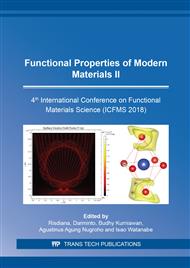[1]
J. Ramprecht, D. Sjoberg, On the feasibility of using ferromagnetic materials for thin EM absorbers, International Conference on Electromagnetics in Advanced Applications. (2007) 324–327.
DOI: 10.1109/iceaa.2007.4387303
Google Scholar
[2]
C. Wang, X. Han, P. Xu, X. Zhang, Y. Du, S. Hu, J. Wang, X. Wang, The electromagnetic property of chemically reduced graphene oxide and its application as microwave absorbing material, Appl. Phys. Lett. 98 (2011) 072906.
DOI: 10.1063/1.3555436
Google Scholar
[3]
Kurniasari, A. Maulana, A.Y. Nugrahaeni, D.N. Jayanti, S. Mustofa, M.A. Baqiya, Darminto, Defect and Magnetic Properties of Reduced Graphene Oxide Prepared from Old Coconut Shell, IOP Conf. Ser. Mater. Sci. Eng. 196 (2017) 012021.
DOI: 10.1088/1757-899x/196/1/012021
Google Scholar
[4]
A. Y. Nugraheni, M. Nasrullah, F. A. Prasetya, F. Astuti, D. Darminto, Study on Phase, Molecular Bonding, and Bandgap of Reduced Graphene Oxide Prepared by Heating Coconut Shell, Mater. Sci. Forum 827 (2015) 285–289.
DOI: 10.4028/www.scientific.net/msf.827.285
Google Scholar
[5]
A. K. Geim, K. S. Novoselov, The rise of graphene, Nat. Mater. 6 (2007) 183–191.
Google Scholar
[6]
S. Sahoo, G. Hatui, P. Bhattacharya, S. Dhibar, C. K. Das, One Pot Synthesis of Graphene by Exfoliation of Graphite in ODCB, Graphene 02 (2013) 42–48.
DOI: 10.4236/graphene.2013.21006
Google Scholar
[7]
R. C. Che, L.-M. Peng, X. F. Duan, Q. Chen, X. L. Liang, Microwave Absorption Enhancement and Complex Permittivity and Permeability of Fe Encapsulated within Carbon Nanotubes, Adv. Mater.16 ( 2004) 401–405.
DOI: 10.1002/adma.200306460
Google Scholar
[8]
H. Zhao, X. Han, M. Han, L. Zhang, P. Xu, Preparation and electromagnetic properties of multiwalled carbon nanotubes/Ni composites by γ-irradiation technique, Mater. Sci. Eng. B. 167 (2010) 1–5.
DOI: 10.1016/j.mseb.2010.01.003
Google Scholar
[9]
K.-H. Liao, A. Mittal, S. Bose, C. Leighton, K. A. Mkhoyan, C. W. Macosko, Aqueous Only Route toward Graphene from Graphite Oxide, ACS Nano. 5 (2011) 1253–1258.
DOI: 10.1021/nn1028967
Google Scholar
[10]
C. Fu, G. Zhao, H. Zhang, S. Li, Evaluation and Characterization of Reduced Graphene Oxide Nanosheets as Anode Materials for Lithium-Ion Batteries, Int. J. Electrochem. Sci. 8 (2013) 12.
Google Scholar
[11]
C.-Y. Chen, N.-W. Pu, Y.-M. Liu, S.-Y. Huang, C.-H. Wu, M.-D. Ger, Y.-J. Gong, Y.-C. Chou, Remarkable microwave absorption performance of graphene at a very low loading ratio, Compos. Part. B. Eng. 114 (2017) 395–403.
DOI: 10.1016/j.compositesb.2017.02.016
Google Scholar


